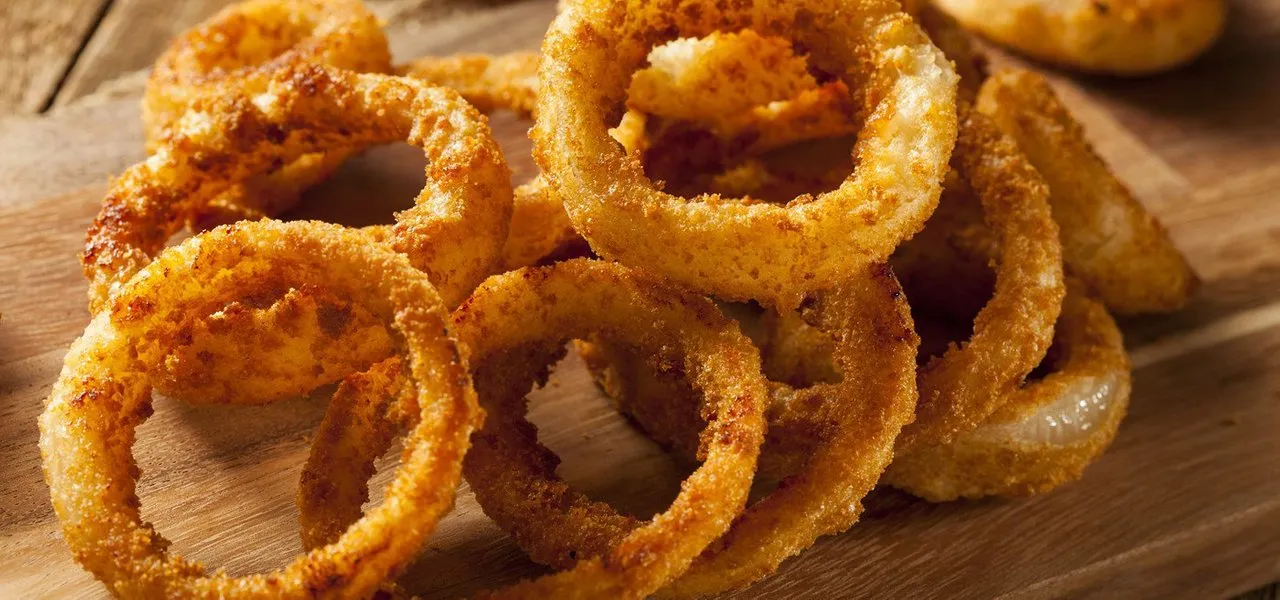
It’s wonderful that modern society is prosperous enough that we can spend our hard-earned discretionary income on luxuries unimaginable to humans from centuries past. These luxuries include cars and computers, but also feature the simple and ubiquitous features of modern life.
The production of an onion ring is an enormously complex process.
Take the onion ring. Made of two basic components, the onion and the breading, subsequently deep fried in fat or oil, the onion ring is almost entirely devoid of substantive nutritional value. It is an amazing luxury that modern man is so wealthy, and so well-fed, that he can eat fried, breaded onions solely for pleasure.
I have recently become fascinated by the deceptively simple beauty of the onion ring. In a tasty, fried shell, it illustrates the essence of a free and prosperous society: the division of labor and exchange, resource allocation through the market process, and the power of the consumer.
I, Onion Ring
The sheer logistical complexity of putting an onion ring on a plate is staggering. From growing the onion and getting it to market, to making everything that’s needed for the breading and batter, and even the oil to fry it in, the production of an onion ring is an enormously complex process.
Much like the pencil in Leonard Read’s famous essay “I, Pencil” an onion ring would be enormously difficult to make all alone. From growing your own onions, crafting a forge to make the knife that will be used to slice the onion, and all the other agricultural production needed to produce the breading and oil, the costs in time and material would be far too great for any self-sufficient individual to bear. Indeed, I can only scratch the surface of all the goods and services necessary for just one onion ring.
Thankfully for onion ring lovers like me, the division of labor in a market economy makes it so one doesn’t have to make onion rings independently.
At no point was there a central director, dictating that one particular person at one particular restaurant would get an exact quantity of onion rings.
A farmer grows the onions, another farmer grows the grain to make the bread for the breading, and a third farmer grows what will eventually become the oil the mixture is fried in. Then there are the factory workers who make the tractors the farmers use, and workers that drill the oil and refine it into gasoline to power the tractor.
Of course, most farmers don’t sell onions, breading, and oil directly to a restaurant. Working through a myriad of third parties like wholesalers and grocery stores, who specialize in the distribution rather than the production of goods, the farmers eventually get the goods to the restaurant.
But even then, the onion ring is still not made. A cook still has to cut the onion (with a knife, made by somebody else), bread it, and fry it. A waiter has to bring the finished, crispy, golden-brown onion ring out to the hungry consumer, who can finally enjoy her treat.
Without exchange and the division of labor, none of this would be possible.
The Layers of the Market Process
At no point in the complex chain of onion ring production was there a central director, dictating that one particular person at one particular restaurant would get an exact quantity of onion rings.
The market process is simply the economic idea that thousands, if not millions, of individual decision makers, seeking their own profit, spontaneously work together to produce a greasy delight (among other things).
Of course, perhaps nobody in the process produces with the end goal of an onion ring in mind. The farmers want somebody to buy their produce, as do the grocery stores. The restaurants want bodies in chairs and returning customers, so they create food that consumers want and that continues to sell.
This market process occurs for millions of goods and services all around the world, every day. The onion ring is just one, simple example.
Diversity in Simplicity
Though the components of an onion ring are simple, the astounding diversity of the onion rings created and served in bars and restaurants signals at their hidden complexity. I should know, I routinely eat and review onion rings at Sola Cepa.
The diversity of onion rings illustrates the strength of a free market at satisfying the wishes of consumers.
The seemingly endless variety of onion rings, in thickness, flavor, preparation, or presentation, illustrates one key, final point about markets. Consumer tastes and preferences play a pivotal role in determining what goods get made, and how.
Onion rings are fairly easy to make and prepare and are a relatively popular appetizer or side dish. Despite the relative simplicity, there is an enormous diversity in the kind and quality of onion rings served. A plethora of restaurants compete to outdo each other, perfecting their onion ring recipes with the end goal of delighting the consumer with fried perfection.
Every restaurant wants customers, and they can only keep their doors open if enough consumers like what they’re selling, and more so than their competitors.
The onion ring is one small proxy of this drive to compete and improve. A restaurant at the top of their game will innovate and perfect even the simple onion ring, while a struggling restaurant might phone it in or order a bulk bag frozen rings instead.
The market caters to all types. A snobbish onion ring connoisseur might turn up his nose at the frozen rings, but a less picky consumer may be happy with something hot and greasy. The diversity of onion rings illustrates the strength of a free market at satisfying the wishes of consumers, even for something as trivial as an onion ring.

Tyler Groenendal
Tyler Groenendal is a graduate of Hillsdale College, and works for the Acton Institute for the Study of Religion and Liberty. He enjoys cats, liberty, and the music of Ritchie Blackmore.
This article was originally published on FEE.org. Read the original article.
